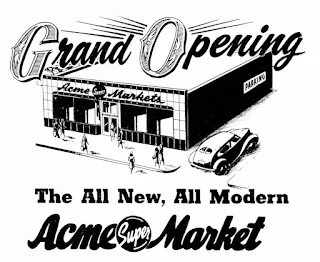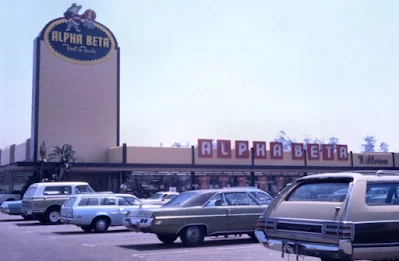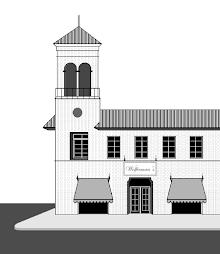The fourteenth Food Store Focus section chronicles the American Stores Company, or ASCO. This retail entity was created when five Philadelphia chain stores merged, on April 2, 1917. One of these, Robinson & Crawford, opened its doors in 1891, a year commemorated on the anniversary graphic above.
Graphic from American Stores Company Annual Report 1938
The Acme Tea Company had been incorporated in June 1900. One of the five original companies, it had the largest number of stores going into the merger. At the time, there were 433.
Graphic from the Acme Tea Company
Graphic from Robinson & Crawford
The last of the five merger participants was Childs & Company, who -in 1917- ran 268 stores. Upon its incorporation, the newly-created American Stores Company was charged with 1,221 corner-type grocery stores.
Graphic from Childs & Company
In 1929, the Marketeria-type store was introduced. Encompassing 1,600 square feet, it was self-service and had an in-house meat department. In 1930, the American Stores store count stood at 2,728. At this time, Asco units operated in Delaware, Maryland, New Jersey, Pennsylvania and the District of Columbia. The corporate headquarters was located in Philadelphia.
Graphic from the American Stores Company
Graphic from the American Stores Company
A nearly snowed-in American Store in Wayne, Pennsylvania. The date, 1934. In the windows, one can see promotions for several of American Stores' house-brand products. These include Asco Teas, Asco Coffee, Asco canned goods, Gold Seal eggs, Louella butter, Gold Seal flour and Victor Bread.
Photo from the Radnor Historical Society / Greg Prichard
American Stores inaugurated their first two supermarkets -in Paterson, New Jersey- in 1937. These operated under the new Acme Markets division (named as a homage to the old Acme Tea Company). In 1939, there were 2,272 American Stores grocery and Acme Market units. A Pennsylvania tax on chain stores was enacted in 1936. It was levied on the number of stores a company had, with American Stores' 1937 bill being $750,000. The tax was rescinded in 1939.
Graphic from the American Stores Company
Acme Market stores proliferated across the Eastern Seaboard. 576 were in operation by 1942. Stores began to install frozen food sections during the war. In 1949, the company was building larger stores with ample parking facilities. A few even had air-conditioning. There were 765 Acme Markets and 872 conventional American Stores units. These were operating in Delaware, Maryland, New Jersey, New York, Pennsylvania and the District of Columbia.
Graphic from the American Stores Company
In November 1949, a new Wayne, Pennsylvania Acme Market was dedicated. It included a large parking lot and 9,500 square feet of selling space.
Photo from the Radnor Historical Society / Greg Prichard
In 1955, stores began giving out S & H Green Stamps with every purchase. The company was in charge of 1,076 units. 736 were self-service Acme Markets, with the remaining 320 being conventional American Stores. Their trade area covered Delaware, Maryland, New Jersey, New York, Pennsylvania, Virginia, West Virginia and the District of Columbia. Locations in Buffalo operated under the Nu-Way Markets and Danahy-Faxon Stores nameplates
Graphic from the American Stores Company
-Circa-1960-
-Circa-1970-
A new "fish eye" logo debuted in 1960. With a few variations, it would serve as the company trademark for 24 years. As of April 1960, there were 810 stores. 760 were self-service Acme Markets, with fifty conventional American Stores still in operation. The American Stores territory covered Delaware, Maryland, New Jersey, New York, Pennsylvania, Virginia, West Virginia and the District of Columbia. On June 27, 1962, the American Stores Company changed its name to Acme Markets, Incorporated.
Graphic 1 from the American Stores Company
Graphic 2 from Acme Markets, Incorporated
The "fish eye" logo was introduced along with a new "A-Frame" store design. The KING OF PRUSSIA PLAZA unit seen above covered 27,000 square feet. The American Stores store count had reached 845, with 811 being self-service Acme Markets. There were an additional thirty-four conventional grocery stores. These would be entirely phased out in 1970. The name of the company reverted back to its original American Stores Company heading on December 29, 1973.
Photo from www.pleasantfamilyshopping.blogspot.com
Meanwhile, American Stores had shifted into an acquisition mode in the early '60s. Alpha Beta Food Markets, of La Habra, California, was obtained on January 16, 1961. Fifty-one supermarkets were included in the transaction. At year's end, the American Stores-Acme Markets entity was operating 840 units in California, Delaware, Maryland, New Jersey, New York, Pennsylvania, Virginia, West Virginia and the District of Columbia.
Graphic from Alpha Beta Acme Markets, Incorporated
On July 26, 1979, Skaggs Companies obtained American Stores and its Alpha Beta division. Skaggs Companies adopted the American Stores heading. Following the merger, the company opened forty-four combination food-drug stores under the Skaggs Alpha Beta nameplate. By the late 1980s, Alpha Beta was in decline, with a reputation for high prices and poor customer service. The chain was slowly phased out between 1988 and 1995.
Photo from the Orange County Archives / California
Meanwhile, an updated logo was introduced in 1981. An American Stores corporate headquarters had been established -in Salt Lake City- in 1980, with Acme Markets' offices remaining in Philadelphia. Several acquisitions and mergers followed in rapid succession. We don't possess the space to describe every transaction. Suffice to say, several concerns were involved, including Chicago's Jewel Companies, Chicago's Osco Drug, Boston's Star Market, California's Sav-On Drug, Montana's Buttrey Food Stores and California's Lucky Stores.
Graphic from the American Stores Company
Graphic from the American Stores Company / https://logos.fandom.com
In June 1999, Boise, Idaho's Albertsons chain acquired American Stores. The merger, which invoked action from the FTC, had required Albertsons to sell 104 supermarkets. American Stores was required to dispose of forty. With the merger completed, the 82-year-old American Stores Company ceased to exist. Albertsons did retain the Acme Markets division, whose headquarters had moved from Center City Philadelphia to Chester County (Malvern), Pennsylvania in 1988.
Photo from Albertsons Companies, Incorporated
Our most recent Acme Markets logo debuted in 1998. It is still the official company trademark. In mid-2023, Acme Markets was operating 161 stores in Connecticut, Delaware, Maryland, New Jersey, New York and Pennsylvania. The average size of an Acme Markets location was 30,000 square feet.
Graphic from Albertsons Companies, Incorporated
ACME MARKETS JUNIOR-ANCHORED SHOPPING MALLS:
*BOULEVARD MALL, Erie County, NY (1962)
*KING OF PRUSSIA PLAZA, Montgomery County, PA (1963)
*SUMMIT MALL, Fairlawn, OH (1965)





















